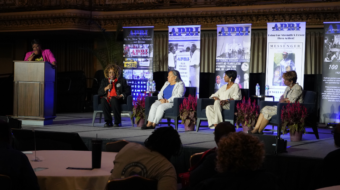TUSCALOOSA COUNTY, Ala. – This is the second bitter winter for 13 families in Brookwood, Ala. They are awaiting a full accounting of the worst coal mining disaster in 17 years and the “official” report from the federal Mine Safety and Health Administration (MSHA) released in December did not to relieve their pain nor bring justice to this tight-knit community of 1,483.
On Sept. 23, 2001, two explosions rocked the Jim Walter Industries (JWR), the coal operator, number five mine in Brookwood. At the end of the day, Gaston Adams Jr., 56, Ray Ashworth, 53, Nelson Banks, 52, Dave Blevins, 52, Clarence Boyd, 38, Wendell Johnson, 52, John Knox, 44, Dennis Mobly, 56, Charles Nail, 59, Joe Riggs, 51, Charles Smith, 44, Joe Sorah, 46, Terry Stewart, 44, were dead and Tony Kay, 49, Michael McIe, 42, and Skip Palmer, 42, were injured. All were members of United Mine Workers of America (UMWA) Local 2368. About 1,400 county residents work at the JWR mining complex.
David Lauriski – MSHA secretary appointed by President Bush in May 2001, former General Manager of Energy West Mining Company and former chairman of the Utah Mining Association – delivered the government’s findings in person in Brookwood. JWR is guilty, said Lauriski, of eight violations directly related to the disaster and 18 other violations at the mine. Although each violation carries a $55,000 fine, for a total of $1.4 million, none were levied. The only action MSHA ordered was the re-organization of the company’s emergency evacuation procedures.
On May 1, 2002, less than eight months after the fatal explosions, MSHA allowed JWR to re-open the number five mine.
Through the third quarter of 2002, ending in September, the total profits from the company’s entire natural resources division, including number five mine, skyrocketed compared to 2001, from $198 million to $406 million, according to company reports.
The federal safety report took 14 months. The agency brought in investigators from five coal-producing states outside of Alabama. MSHA found that at 5:17 p.m. on Sept. 23, a roof collapsed in one section of the mine. Rocks buried a battery charging station and damaged the ventilation system. Methane gas filled the section.
A spark from the battery station ignited the methane injuring four miners, one so badly he could not walk. Methane continued to build, now mixed with volatile coal dust. News spread through the mine of the explosion and miners came to rescue the injured miner.
The electricity was shut off, except for a traffic signal for the underground rail system. As miners approached the damaged section, the rail traffic signal ignited the methane and coal dust mixture setting off the second deadly explosion.
MSHA said that coal dust was a “critical factor in the severity of the second explosion.” Federal safety standards require coal mines to be blanketed with powdered limestone to dilute the volatile coal dust and prevent it from fueling an explosion.
The UMWA charges that the investigation does not go far enough and will issue its own findings. While MSHA’s Dec. 11 report acknowledges serious safety violations – a number of which were cited for high negligence – and supports the UMWA’s findings of pre-existing hazardous conditions, said union president Cecil Roberts, “we feel it does not represent a thorough examination of all the facts in the investigation.”
“We concur with MSHA report that management’s failed emergency plan as well as JWR’s failure to control mine roof problems, failure to properly examine the mine and failure to control explosive coal dust were clear factors in the deaths of 13 miners.”
However, the union will identify other elements, Roberts said, and miners and their families are anxiously awaiting an internal review of MSHA to explain why the agency failed to enforce the law prior to the explosions. “If those violations had been followed up on and rectified, could lives have been saved?” he concluded.
In 1999, MSHA records show that all three mines, including number five, in the JWR Brookwood complex were cited a total 600 times. MSHA cited mine number five 10 times for “significant and substantial safety violations” in the two months preceeding the explosions.
Contributing to company’s soaring profits for 2002, is their methane gas business, Black Warrior. It employs 12 workers and is an integral part of the Brookwood complex. Even the “Birmingham Business Journal” ironically commented on Oct. 8, 2001, less than month following the fatal explosions, “Meanwhile, the deadly methane gas blamed for the two mine explosions continues to be a big money maker for the company.”
The three mines comprising the Brookwood complex are the deepest in North America and number five, at a half mile, is the deepest. Methane gas is plentiful at these depths and a constant companion for miners.
The UMWA has established a relief fund for the families: UMWA 2368, P.O. Box 99, Brookwood, AL 35444.
PDF version of ‘Guilty coal operator takes no action’










